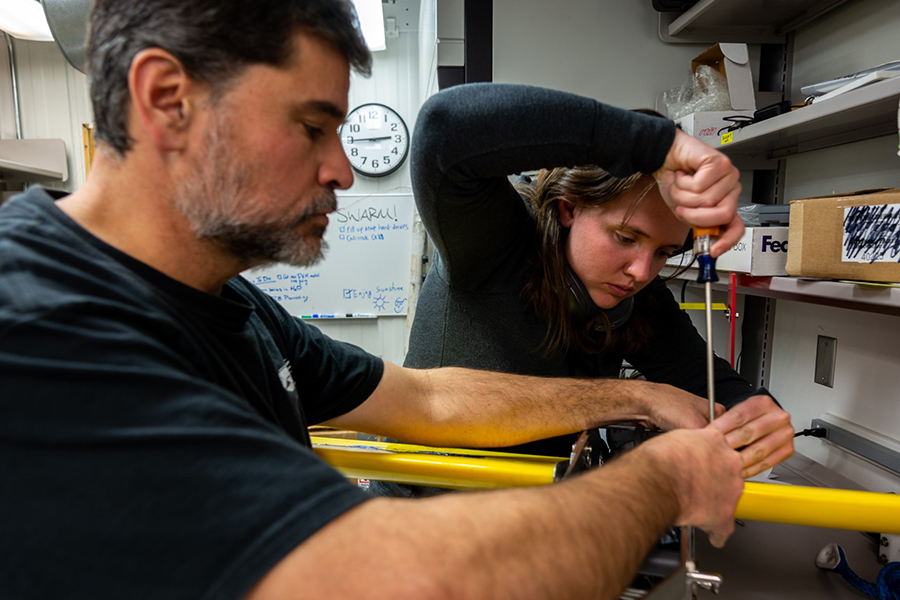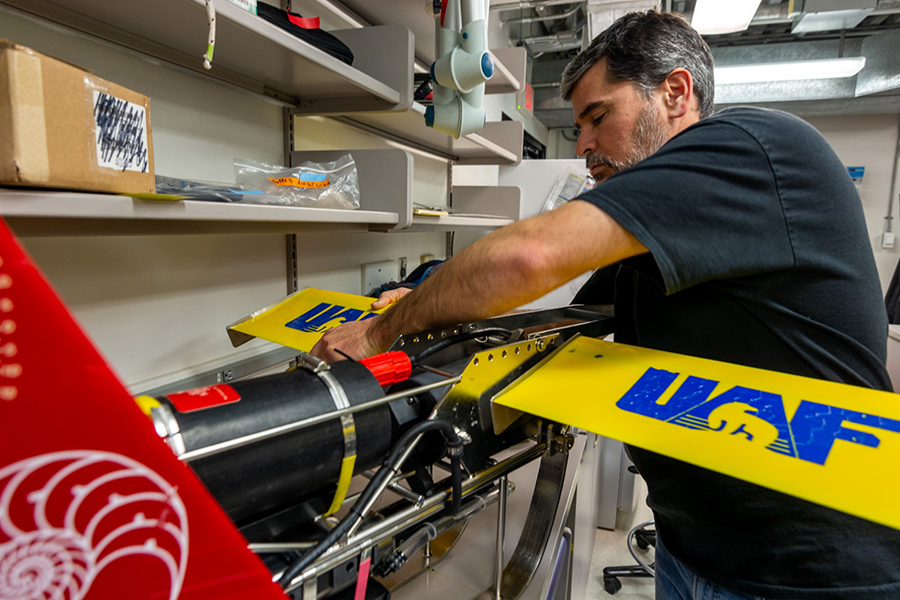Detecting Anomalous Life SwarmsScientists Investigate What Makes a Biological Hotspot so HotPosted September 1, 2020
The seas around Antarctica are alive, but that life is not evenly distributed everywhere. Vast regions of barren ocean are punctuated by oases of concentrated nutrients that create hotspots of biological activity. 
Photo Credit: Mike Lucibella
Josh Kohut (left) and Katie Hudson adjust an instrument package towed behind the boats as they traverse along the Palmer Deep canyon.
"This area south of Palmer Station is a well-known biological hotspot," said Josh Kohut, an oceanographer at Rutgers University and principal investigator. "What is not well known are the mechanisms that make it a biological hotspot." His project, known as "Swarm", is taking a close look at the region to understand exactly what makes it so bountiful. They're focusing on an area known as the Palmer Deep, a bowl-shaped underwater canyon located about five miles away from Palmer Station on the Western Antarctic Peninsula. The Swarm team spent the past austral summer using a range of instruments including high-frequency radar current mappers, ocean gliders, and underwater moorings to measure everything they could about the oceanography and ecology of the region. With this ocean observatory, they hope to get a detailed picture of the kind of influences that create the conditions where these hotspots form, not just around the Palmer Deep, but along the whole Antarctic Peninsula. The research is supported by the National Science Foundation, which manages the U.S. Antarctic Program. Oceanic ConnectionsMuch of the open ocean is relatively barren of life. Nutrients are dispersed, as are the organisms that feed off of them. But there are sporadic biological hotspots throughout, discreet areas where life is abundant, and food is plentiful. "Figuring out how biological hotspots work in general is a pretty big question in the ocean, because it's not like life is uniformly distributed across the surface of the ocean," said Matt Oliver, an oceanographer at the University of Delaware. "You have these persistent hotspots that are highly productive either in fisheries, or whatever it is, and there's been a lot of work in trying to figure out what makes these things tick." The waters above the Palmer Deep is one such hotspot and the Swarm team is working to understand why. On one level, they're trying to figure out where the phytoplankton there comes from. "One of the ideas was that the canyon serves as an incubator, meaning it's really productive, it brings nutrients to the phytoplankton at the surface," Kohut said. "What we're finding… is that the surface of the ocean flushes and replenishes itself too frequently for those things to grow locally." 
Photo Credit: Matt Oliver
The team heads out on a boat known as a RHIB to collect samples from the Palmer Deep. (Left to right) Matt Oliver, Katie Hudson, Nick Mehmel and Josh Kohut.
He's building on work hinting that phytoplankton, marine algae that form the basis of much of the ocean's food web, might be carried in by currents rather than growing locally. "What we think is actually happening is food that is growing somewhere else, phytoplankton that is actually grown somewhere else, is being transported here. And so it's a consistent and persistent delivery of food resources that come to this place," Kohut said. "Our suspicion is that it's [coming from] the shelf itself, that there are areas north and south of there that are basically just pulling from a larger area where that growth could be happening and delivering it there." He added also that the reason the hotspot exists where it does is because the canyon itself causes ocean conditions that trap for particles and critters moving through it. "Nothing leaves, so once you get into the circulation into the bowl, there's no exit. It accumulates particles, possibly krill, over time," Kohut said. More broadly, they're also trying to gain a deeper understanding of how hotspots like this function throughout the ocean, and how they might respond to warming oceans. The seas around Palmer make for an ideal site to investigate these hotspots because of the relative simplicity of its ecosystem. "We have a relatively short food web. We basically go from phytoplankton to krill then to the top predators," Oliver said. "We're really only trying to keep track of three categories, whereas in other situations it's not like that, it's a lot more complex. If you think of a hotspot like a coral reef system, it's a little more complex." However, food webs are inherently complicated. Even relatively simple ecosystems like the seas around Palmer are made up of many different organisms that respond in unique ways to each other and their environment. "What we're trying to do is understand the mechanisms that connect the ocean to the ecology," Kohut said. "We know that the ecology is dependent on the ocean, but we don't know the details. We need to understand at those mechanistic levels to be able to predict what's going to happen in the future if we're thinking about these dramatic climate change situations." The Antarctic Peninsula is one of the fastest-warming regions on the planet, and as the ocean changes, the connections between organisms that have existed for millennia are changing as well, sometimes dramatically. "The reason we're here is to understand the underlying processes that link the ocean to the ecology - the top predators through the prey and the primary producers - so that we can better understand what a future climate might look like," Kohut said. "In a future scenario the ocean is not going to look like it has looked for the past 30 years, so you can't use those connections. You have to understand actually how the penguins are interacting with this environment in order to say ‘If we know that, we see how the environment is going to change over the next 30 years, now we can see how those connections might change.'" How biological hotspots form and how they might react to a changing climate is a broad question, one that numerous researchers the world over are working on. But focusing in on one small piece of the puzzle, where the phytoplankton around the Palmer Deep originates, can offer insights throughout the region. 
Photo Credit: Matt Oliver
Josh Kohut (left) and Hank Statcewich pose next to the power station on the Wauwerman Islands that powers the team's high frequency radar station.
"If we know the geometry and the interaction of the tides of this feature, we could see whether or not that phenomena is replicated up and down the coast, and whether or not those are also biological hot spots," Kohut said. He's working with researchers from Old Dominion University who are developing a comprehensive model of the oceans and ecosystems around the Antarctic Peninsula. The information Kohut collects will help further improve that model, making the already powerful predictive tool even more so. "If the model is representing accurately what's happening there, than the model becomes an awesome tool," Kohut said. "We can turn the tides on and off. We can change the winds. We can test hypotheses about why this place is a hotspot, why these pathways might exist, are they because of tides, are they because of winds, and are they because of the timing of the sea ice melt? We can test all that in a model much easier than we can in the real world." Life Above the Palmer DeepThe Swarm team brought a bevy of equipment to Antarctica to observe the oceans and the creatures living within. It's an expansive toolset, as the project ties together numerous disciplines and observations about every level of the ocean environment, ranging from the very bottom of the food chain, all the way to the top. "We go from the individual cellular level primary producers, up into the krill that are a little bigger, up to the penguins," Oliver said. "Not only scaling up sizes, you're scaling up the physical processes that are important at those scales." It's a broad approach that requires a tremendous amount of data and numerous different instruments to collect it. To get a clearer picture of the ocean itself, they deployed underwater moorings at several locations to measure ocean conditions and currents. In addition, to better map the currents around the region, the team also set up high-frequency radar systems on three different islands around Palmer Station. 
Photo Credit: Mike Lucibella
Josh Kohut adjusts an instrument package from the University of Alaska Fairbanks towed behind the boats as they traverse along the Palmer Deep canyon.
"It's sending out radio waves that bounce off the ocean waves on the surface," Kohut said. "We know how fast a wave of a certain wavelength should be moving in the ocean. Whatever the difference is from that speed is attributed to ocean current." Phytoplankton have no real ability to move on their own so they're entirely dependent on ocean currents for mobility. Because they form the basis of the ocean's food web, where they go, predators should follow. "One of the things that we're testing is how features like eddies and fronts in the currents might concentrate or focus the food web in certain places, and do the predators go to those locations when they're seeking out krill or whatever their prey is," Kohut said. "By having these three stations were able to map an area that covers completely the Palmer Deep biological hotspot and those maps update every hour." To gather data about the biologic hotspots, the team also deployed three autonomous ocean gliders, automated sea vehicles that move through the water using buoyancy and the ocean's currents. These kinds of gliders are common tools for marine research, usually equipped with instruments to measure ocean characteristics, such as temperature and salinity, as well as for the presence of biological signals, such as particle density, ocean oxygen levels, and the presence of chlorophyll. "[What's] new this year, all these gliders have active acoustics for looking at krill," Kohut said. Giant swarms of thousands or even millions of krill will descend in a feeding frenzy around hotspots of phytoplankton in concentrations so dense they show up on sonar. Kohut's gliders are outfitted with echo sounders that ping underwater soundwaves off of the krill to measure the size and density of the swarms. "The data from these echo sounders is really pretty amazing," Kohut said. "You can actually see the movement of different organisms." In addition, the team is also working with the penguin research team in the area to track where penguins are going to feed. Using birds tagged with locators, the teams can see where the preferred spots penguins go to forage, and then compare conditions at those locations to the data gathered by their other instruments. Deploying and operating of these technologies, combined with more traditional sample collection trips, meant a full season at Palmer Station for the Swarm team. Since the end of the austral summer, they returned to their home institutions and started putting together a more coherent picture of where the phytoplankton are coming from that makes the area around Palmer Deep so bountiful. The team next hopes to take lessons learned from mapping and scrutinizing this region, and apply those more broadly along the Peninsula. NSF-funded research in this story: Josh Kohut, Rutgers University, Award No. 1745009. |



For USAP Participants |
For The Public |
For Researchers and EducatorsContact UsU.S. National Science FoundationOffice of Polar Programs Geosciences Directorate 2415 Eisenhower Avenue, Suite W7100 Alexandria, VA 22314 Sign up for the NSF Office of Polar Programs newsletter and events. Feedback Form |


